Non-fatal injuries 200+ Total number of deaths 85 | Start date August 2, 1980 Attack type Bomb | |
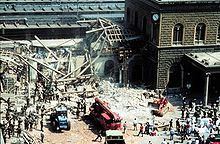 | ||
Similar Piazza Fontana bombing, Italicus Express Bombing, Piazza della Loggia b, Train 904 bombing, Portella della Ginestra | ||
Gabriele adinolfi accused of bologna massacre and intro on gladio b
The Bologna massacre (Italian: strage di Bologna) was a terrorist bombing of the Central Station at Bologna, Italy, on the morning of 2 August 1980, which killed 85 people and wounded more than 200. The attack was carried out by the neo-fascist terrorist organization Nuclei Armati Rivoluzionari (Armed Revolutionary Nuclei), which always denied any involvement; other theories have been proposed, especially in correlation with the strategy of tension. The bombing is the fifth deadliest terrorist attack in Western Europe behind the Nice attack in 2016, Paris attacks in November 2015, the Madrid train bombings in 2004, and the bombing of Pan Am Flight 103 in 1988.
Contents
- Gabriele adinolfi accused of bologna massacre and intro on gladio b
- Aphg bologna massacre
- Bombing
- Investigations
- Disinformation and false leads
- Prosecution and trial
- Alternative hypotheses
- Legacy
- Victims association
- References
Aphg bologna massacre
Bombing
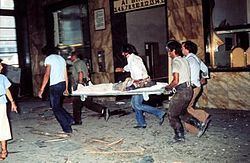
At 10:25 a.m., a time-bomb contained in an unattended suitcase detonated inside an air-conditioned waiting room, which, the month being August (and with air conditioning being uncommon in Italy at the time), was crammed full of people. The explosion destroyed most of the main building and hit the Ancona–Chiasso train that was waiting at the first platform. The blast was heard for miles. The roof of the waiting room collapsed onto the passengers, which greatly increased the total number killed in the terrorist attack.
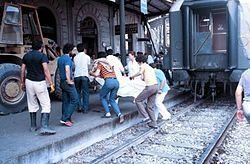
On that summer Saturday the station was full of tourists and the city was unprepared for such a massive incident. Many citizens and travelers provided first aid to victims and helped to extract people buried under the rubble. Given the large number of casualties, since the ambulances and emergency vehicles were not sufficient for the transport of the injured to the city's hospitals, firefighters also employed buses, in particular the line 37, private cars and taxis. In order to provide care to the victims of the attack, doctors and hospital staff returned from vacation, as well as departments, closed for summer holidays, were reopened to allow the admission of all patients.
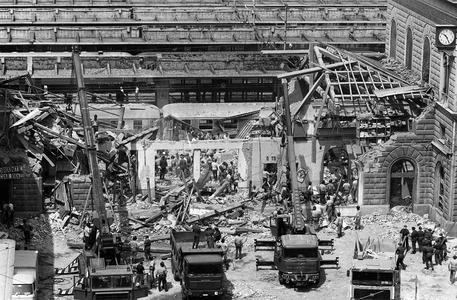
In the following days the central square of Bologna, Piazza Maggiore, hosted large-scale demonstrations of indignation and protest among the population, in which were not spared harsh criticism and protests addressed to government representatives, who attended the funerals of the victims celebrated in the Basilica San Petronio on 6 August. The only applause was reserved for the Italian President Sandro Pertini, who arrived by helicopter in Bologna at 17.30 on the day of the massacre, and said in tears in front of reporters: "I have no words, we are facing the most criminal enterprise that has ever taken place in Italy."
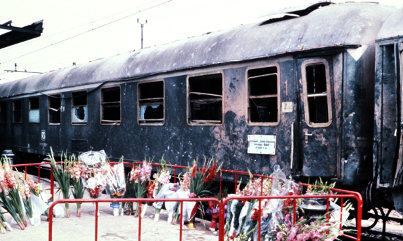
The bus no. 37, together with the clock stopped at 10:25, remained a symbol of the massacre. The attack was recorded as the worst atrocity in Italy since World War II.
Investigations
The next day, police investigators found metal fragments and scraps of plastics near the source of the explosion.
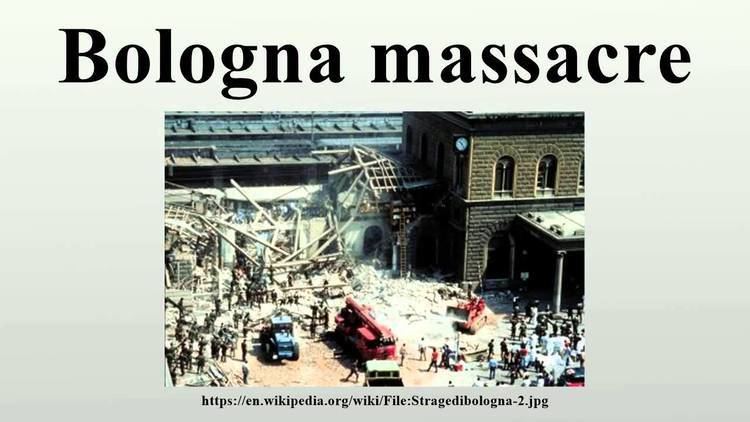
The bomb was later found to be composed of 23 kg of explosive, a mixture of 5 kg of TNT and Composition B, improved from 18 kg of T4 (nitroglycerin for civil use).
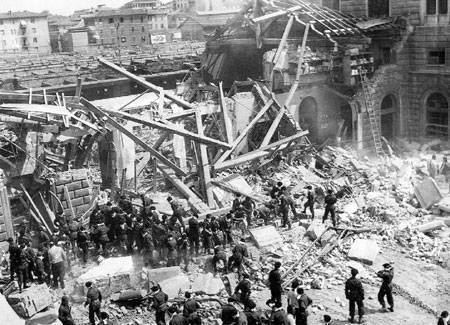
The Italian Government led by Christian Democrat Prime Minister Francesco Cossiga first assumed the explosion to have been caused by an accident (the explosion of an old boiler located in the basement of the station). Nevertheless, soon the evidence gathered on site of the explosion made it clear that the attack constituted an act of terrorism. L'Unità, the newspaper of the Italian Communist Party (PCI) on 3 August already attributed responsibility for the attack to neo-fascists. Later, in a special session to the Senate, Cossiga supported the theory that neofascists were behind the attack, "unlike leftist terrorism, which strikes at the heart of the state through its representatives, black terrorism prefers the massacre because it promotes panic and impulsive reactions."
Disinformation and false leads
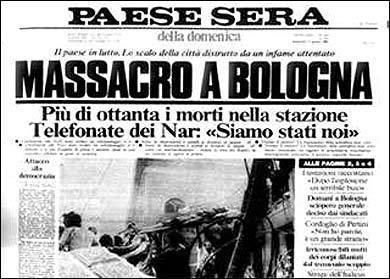
Almost immediately after the bombing, the press agency Ansa received a telephone call from someone purporting to represent NAR claiming responsibility. The call later proved to be fake, and to have originated from the Florence office of SISMI, the Italian Military Secret Service. Federigo Manucci Benincasa, director of the Florence branch of SISMI, would later be charged with obstruction of justice.
In September 1980 a "Lebanese connection" was manufactured, involving Al Fatah, Phalangists, Italian radicals and Swiss journalists tied to the Italian intelligence community, who supplied investigators with fake notes, memos, and reports. This was followed by a "KGB connection" fostered by head of Intelligence General Giuseppe Santovito, a member of P2, and Francesco Pazienza.
Generals Pietro Musumeci, a member of P2, and Giuseppe Belmonte of SISMI had a police sergeant put a suitcase full of explosives, of the same type that blew up the station, on a train in Bologna. The suitcase also contained personal items of two right-wing extremists, a Frenchman and a German. Musumeci also produced a phony dossier, called "Terror on trains". General Musumeci was charged with falsifying evidence in order to incriminate Roberto Fiore and Gabriele Adinolfi, two leaders of Terza Posizione who had fled to London. Both Terza Posizione leaders claimed that Musumeci was trying to divert attention from Licio Gelli, (head of the "masonic" lodge P2).
Licio Gelli and Francesco Pazienza were convicted of obstructing the investigation, as were Generals Pietro Musumeci, and Giuseppe Belmonte of SISMI.
Prosecution and trial
The attack has been attributed to the NAR (Nuclei Armati Rivoluzionari), a neo-fascist terrorist organization. A long and controversial court case began after the bombing. Francesca Mambro and Giuseppe Fioravanti were sentenced to life imprisonment.
In April 2007 the Supreme Court confirmed the conviction of Luigi Ciavardini, a NAR member associated closely with close ties to Terza Posizione. Ciavardini received a 30-year prison sentence for his role in the attack. Ciavardini had been arrested following the armed robbery of the Banca Unicredito di Roma on 15 September 2005. Ciavardini was also charged with the assassination of Francesco Evangelista on 28 May 1980, and the assassination of Judge Mario Amato on 23 June 1980.
On 26 August 1980, the prosecutor of Bologna issued twenty-eight arrest warrants against far right militants of the NAR and Terza Posizione. Among those arrested were: Massimo Morsello (future founders of Forza Nuova), Francesca Mambro, Aldo Semerari, Maurizio Neri and Fascist militant Paolo Signorelli. They were interrogated in Ferrara, Rome, Padua and Parma. All were released from prison in 1981.
Main stages of the trial:
On 12 February 1992 the United Sections of the Criminal Court of Cassation acquitted Roberto Rinani and Paolo Signorelli from the charge of murder (Signorelli is also acquitted for armed gang and subversive association). It also acquitted a number of other defendants od various charges, cancelled the judgment and ordered a new trial. The Court of Cassation declared the appeal process must be redone, because the sentences were deemed "illogical, incoherent, not assessing proofs and evidence in good terms, not taking into account the facts preceding and following the event, unmotivated or poorly motivated, in some parts the judges supporting unlikely arguments that not even the defense had argued".
In April 1998, Francesca Mambro was authorized to leave her prison during the day, and carried out activities against the death penalty in the headquarters of the Radical Party.
In June 2000, Massimo Carminati (NAR member), Ivano Bongiovanni (thug with sympathy for far-right) and Federigo Manucci Benincasa (SISMI officer) were convicted for obstruction. Carminati and Manucci Benincasa were acquitted for lack of evidence in December 2001, while the use of Bongiovanni is declared unreliable (the conviction becomes final). On 30 January 2003, the Court of Cassation finally acquitted Carminati and Manucci Benincasa.
Alternative hypotheses
Due to the protracted legal procedures over the years and the numerous proven false leads, there developed a number of assumptions and divergent political interpretations around to the real perpetrators and masterminds of the attack.
Italy since the birth of the First Republic was, as everyone knows, a country with limited sovereignty (...) now, when, for immediate issues ( ...) has – rarely – made choices that have been found contrary to the covenants to which I said, it made, as said in a mafia-political-diplomatic terms, a sgarro, a "bad mistake". And like in the mafia when a kid is wrong he ends up in some concrete pillar or is deprived of a relative (commonly called "cross-revenge"), so it is among states: When any country is wrong, one does not declare war, but it sends a "warning", as a bomb exploding in a square, on a train, a ship, etc. etc.
Legacy
The municipality of Bologna together with the Associazione tra i familiari delle vittime della strage alla stazione di Bologna del 2 agosto 1980 hold an annual international composition competition, which culminates with a concert in the town's main square, Piazza Maggiore annually on 2 August, which is also the day designated as a national memorial day for all terrorist massacres.
The area of the station where the bomb detonated has been reconstructed but, as a memorial of the attack, the original floor tile pierced by the detonation has been left in place and a deep crack closed by a glass panel has been made in the reconstructed main wall. As a further memorial, the station clock that stopped at 10:25 due to the explosion, has been repaired but permanently set at that time.
Victims' association
Relatives of the victims formed an association (Associazione dei familiari delle vittime della strage alla stazione di Bologna del 2 agosto 1980) to raise and maintain civil awareness about the case. The victims' association (Associazione tra i familiari delle vittime della strage alla stazione di Bologna del 2 agosto 1980) was formed on 1 June 1981 in order to "get due justice with possible initiatives", made up initially of 44 people; the number of members later grew to 300 elements.
The association in the years following the massacre remained active, both for the memory of the massacre and to propose initiatives that were added to the investigation. Quarterly, its components are used to go to the court, in order to meet prosecutors and, out of the meeting, even launching a news conference for information on the state of things.
On 6 April 1983, the Association, together with the associations of victims of the massacres of Piazza Fontana, Piazza della Loggia and Italicus train, formed, based in Milan, the Union of Relatives of Victims to Massacres (Unione dei Familiari delle Vittime per Stragi).
